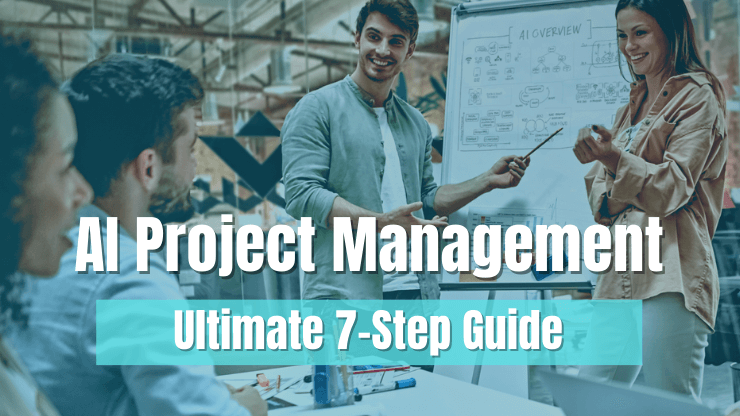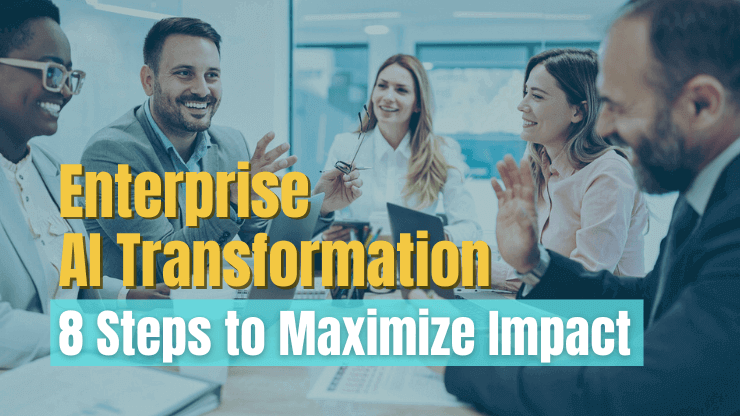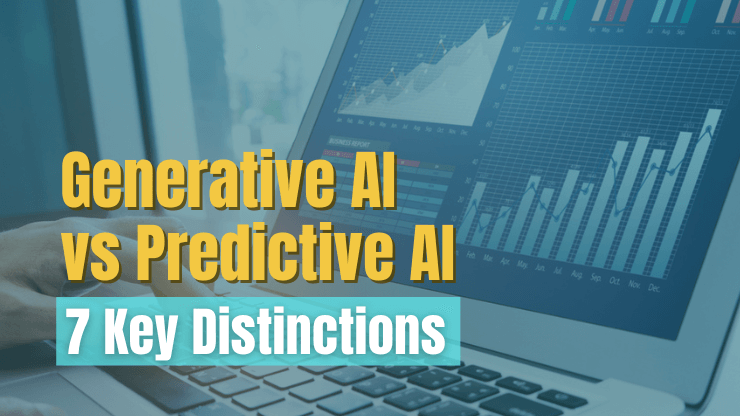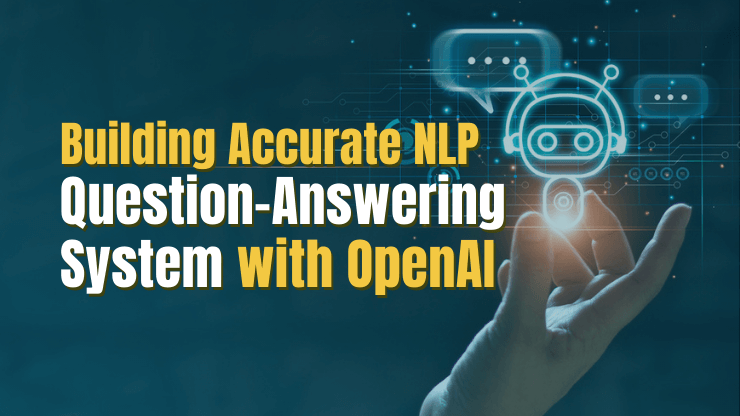AI projects can be difficult to manage due to their unpredictable nature. From setting the right expectations, through gathering necessary input data, to testing various approaches to the problems that are discovered on the way to the final solution, the process is far from easy. In fact, AI projects are so challenging that 85% of AI projects fail to deliver on their intended promises to the business.
In this ultimate guide to AI project management, we’ll help you tackle your AI project with confidence and ensure you don’t become a part of this statistic. We’ll cover:
- Key differences between AI projects and traditional software projects
- Must-have project characteristics to ensure success
- 7 step guide to AI project management
So, let’s get started on your journey to AI project success!
What makes AI projects different from traditional software projects?
The AI project management process is not the same as managing a traditional software project. In fact, the Project Management Institute has reported that 88% of organizations have gaps in their project management practices when it comes to AI projects. Teams should make adjustments to how they manage projects and account for the following differences:
- AI projects require more experimentation than traditional software projects. Because of this, project progress may not be as linear. Take this into account during the project scheduling process.
- ROI for AI projects is harder to estimate. Due to the long-term nature of AI projects and their dependence on many factors, predicting the exact ROI is difficult and can be subject to change over time. Additionally, the success of an AI project is dependent on data quality, management, and implementations of the AI technology.
- AI technology is evolving quickly. AI projects must keep up with the latest advances in AI technology in order to remain competitive, and must be designed with scalability and flexibility in mind in order to be able to adapt to changes to AI models.
Characteristics for successful AI projects

To minimize risk and ensure success with your next AI project, the project management team should ensure the project has been thoroughly vetted for the following three key characteristics:
Viable
First, your AI project should be viable. Viability is defined as a project’s ability to meet the goals of its stakeholders and to satisfy the requirements of its users. For artificial intelligence (AI) projects, viability often hinges on data maturity.
Data maturity can affect the accuracy of machine learning models, which depend on data to make accurate predictions. Furthermore, data maturity can affect the cost and speed of development, as the more work required to gather, organize, and pre-process the data, the more expensive and time consuming the project will be.
To evaluate data maturity, and thus project viability, the project manager should consider if the team has:
- A clear and well-defined process for data collection, cleaning, organization, and storage
- Automated systems in place to ensure data is up-to-date and accurate
- Consistent data quality standards and metrics in place to measure data accuracy and completeness
- Data governance and security protocols in place to protect data and ensure compliance with regulations
Simple
Next, your project should be simple. Particularly if your team is new to working with AI, it’s important to limit the complexity of your project. A project that is low on complexity and technicality will help you achieve tangible business outcomes, establish AI project management processes, and create a sense of excitement and momentum around AI in the organization, without adding unnecessary project risk. To ensure simplicity, your project should:
- Have a limited scope. Don’t try to address too many business challenges with one solution.
- Require a small to medium sized data set. The less data you have to work with, the lower the complexity.
- Focus on an MVP. AI projects should be iterative. Focus your attention on delivering an MVP, then build on top of it to achieve a more complex solution.
Valuable
Finally, every AI project should provide real, tangible business value. Like with any investment, your project managers should evaluate the ROI of the project before investing the time and resources into further technical investigation, solution planning, and implementation. There are three key ways that AI projects can provide business value:
- Automation: Reduce costs by automating tasks and processes
- Data access: Enhance data access and simplify data analysis
- New products: Build a market-ready product that utilizes AI
7 step AI project management guide
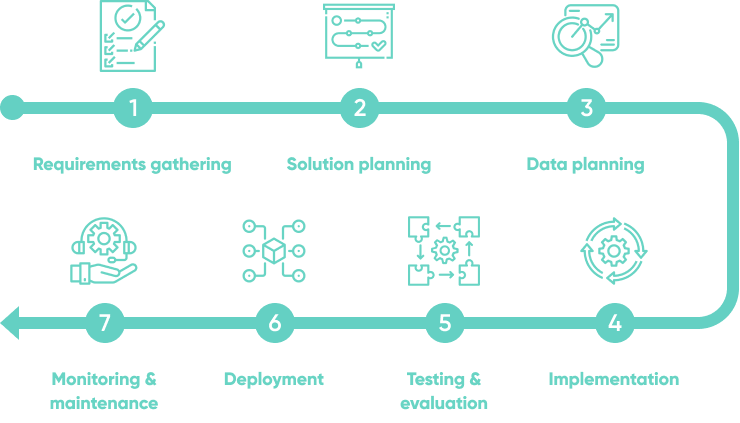
Today, most AI projects utilize a combination of waterfall and Agile processes. AI projects are born in waterfall-like planning and transition to Agile planning once data flows and modeling architecture becomes stable and the project is no longer in experimentation mode.
As the industry matures, processes and tools will evolve to support a full Agile approach. But for now, your project management methodology should embrace a combination of waterfall and Agile processes.
Let’s walk through the AI project development process:
Requirements gathering
The first step of an AI project is requirements gathering and documentation. As with any development project, requirements will set the foundation for the project and ensure it is able to be built to the stakeholders’ and users’ expectations. As part of the requirements gathering process, project managers should define:
- Project overview: Outline the purpose of the project, the desired outcome, and any specific goals and objectives to be achieved.
- Roles & responsibilities: List all project team members, including who the project stakeholders are, who will provide input for defining the project’s requirements, and who the levels of management are. Use task management tools to assign work to individual team members throughout the project..
- Constraints: Document any project constraints that could affect the project planning. This could include time, budget, or technology constraints.
- Technology stack: If you already have a tech stack selected, it’s important to document it at this stage. However, we recommend that the exact AI tools you use be left up to the technical team.
- Functional requirements: Thoroughly document all requirements that define how the system should function from a user’s perspective.
- Non-functional requirements: Include requirements that define how a system should perform in terms of its attributes, such as reliability, scalability, and security.
- Testing and validation plan: Explain the process of testing the software requirements, including the use of test cases and specifications.
PRO TIP: During the traditional software project requirements phase there is a tendency to define the super product, a product that contains every feature and technology we can think of. When working with AI for the first time, it’s best to keep the scope as small and precise as possible.
Read More: 6 Steps to Creating a Successful Requirements Management Plan
Solution planning
Now that you have your project requirements defined, you should hand them over to the development team who will begin their own evaluation and solution planning work. Solution planning should roughly follow these steps:
- Conduct a feasibility analysis: Before proceeding with the development of the solution plan, it is essential to conduct a feasibility analysis to assess the technical, economic, and operational feasibility of the project. This involves the technical team evaluating the project's requirements, constraints, and risks. Based on the findings, the project scope and requirements may need to be adjusted.
- Identify the AI approach: Based on the feasibility analysis, the team should identify the most suitable AI approach for achieving the goals of the project. This may involve choosing between supervised, unsupervised, or reinforcement learning, or a combination of these approaches.
- Select the technology stack: Considering the constraints and requirements of the project, along with the AI approach that has been selected, the team should select an appropriate technology stack, which could include: one or more AI models, cloud platforms, data exploration tools, and development platforms.
- Design the architecture: The team should design the AI architecture that will be used for the project. This includes identifying the algorithms, models, and frameworks that will be used, as well as the infrastructure and tools required. The architecture should take into account the tech stack as well as the project’s constraints.
- Develop the solution plan: Based on the AI approach and architecture, the team should develop a solution plan that outlines the project's implementation details. This should include a detailed description of the AI approach, technology stack, development requirements, and evaluation strategies. It should be written in a way that can feed into the development of a data plan.
Data planning
With a solution plan in place, it’s now time to further develop the data plan for your AI project. Depending on the expertise of your team and resource management strategy, this work could be done by the same team that developed the solution plan, or the solution plan could be handed off to an independent data team.
Regardless, your data plan will define both the scale of data that is needed to achieve the level of accuracy required as well as the source of the data.
Think about where you will source your data. Will it require purchasing a license, data scraping publicly available websites, or will all assets be gathered from internal sources? There are many options to consider, including:
- Past data: Often AI capabilities will be built on top of an already existing product, which means you may have data that’s been collected by your product that you wish to use. All you would need to do in this case is organize and make it machine learning friendly (data cleansing).
- Manual data collection: This involves hiring data labelers and having them manually label datasets. This is often a costly process and can take a long time.
- Automated data collection: This involves using automated tools and scripts to scrape data from websites and other sources. This can be less expensive than manual data collection, but the quality of the data may not be as high.
- Purchased datasets: Buying datasets from third-party data providers can be a cost-effective way to get large amounts of data quickly, but it may require additional work to clean the data of any irrelevant or incorrect information.
- Generative models: Generative models are a type of AI algorithm that can learn the underlying structure of a given dataset and can generate new data based off of what it learns. The generated data can then be used to augment the original dataset for the AI project.
The data plan should also include details about how you will preprocess the data that you collect. The type of preprocessing required will depend on the type of data as well as your end solution. Generally, it involves cleaning and transforming raw data into a format suitable for use in an AI solution in order to reduce noise and improve model accuracy.
Implementation
Implementation is the process of translating the solution and data plans into reality.
Teams who are in the implementation phase of an AI project should follow these key steps:
- Gather data: Collect the necessary data for the project from the data sources identified in the data plan. Ensure you have enough data to achieve the level of accuracy you are expecting.
- Clean the data: Remove any irrelevant or redundant information from the data so it is suitable for use in the project. This is a critical step to ensure that the model is able to achieve the desired results.
- Train the model: If you’re building your own AI mode, this is when you will use the data collected to train the AI model so it can recognize patterns and make predictions.
- Develop the models: This includes selecting and tuning the parameters and hyperparameters to ensure the models are running as expected and are producing the desired results.
- Validate the models: You will do further testing and evaluation work in the next step, but iterative validation should be an active part of the implementation work. Validate the models by testing them on real-world data to ensure they are accurate and reliable. Make modifications in real time to enhance the model’s performance.
- Integrate the components: This includes ensuring that all the components of the project are properly connected, including the data pipelines.
Testing and evaluation
After the implementation phase, thorough testing should be done to ensure that the models are running efficiently, meeting the expected accuracy levels, and running within the expected time limits. Traditional black box and white box testing can be employed to test AI systems. This could look like utilizing one or more of the following specific testing methods:
- Model performance testing: Evaluate the model performance on test data/new data sets to measure parameters such as precision, recall, F-score, and confusion matrix (False and True positives, False and True negatives) against predetermined accuracy.
- Predictive model testing: Evaluate how well a predictive model generalizes to an independent data set. This is done by testing the model on unseen data, or data that the model has not seen during training. The goal of predictive model testing is to determine how accurately the model can predict the outcome of unseen data.
- Metamorphic testing: Test the system with mutated input data. The quality of the output of the system is then evaluated to see if it remains consistent with the expected output. The idea behind this type of testing is to identify any hidden flaws or errors in the system that might not be detected by traditional testing methods.
- Dual coding/algorithm ensemble: Use two or more algorithms to test the same data set. The algorithms are then compared and analyzed to determine which is most accurate and/or efficient. This type of testing is important to ensure the accuracy of an AI system and to identify any potential issues with the system.
One of the most challenging aspects of AI testing is obtaining test data sets that can be used for:
- Measuring accuracy and reliability. The data should be labeled by experts and tested against customer feedback in order to ensure accuracy.
- Identifying anomalies and potential issues with the AI system. It can also help to identify potential improvements or changes that need to be made in order to improve system performance.
- Keep performance in check. This is important in order to ensure the AI model is continually improving and delivering the desired results.
Deployment
Deploying an AI project is a vital step in AI project management. This is where you make your AI software available to your target audience, whether internal users or customers. The exact process for deploying an AI software tool depends on the type of AI tool, the environment in which it will be deployed, and the infrastructure required for the deployment, however, in all cases the following considerations should be weighted by the project leaders as part of the deployment process:
- Security: Ensure that the data is secure, the system is not vulnerable to attack, and that the users’ privacy is respected.
- Performance: Ensure the AI tool continues to perform as expected and meet the desired performance goals.
- Scalability: Consider the number of users, the amount of data, and the number of models that will be running simultaneously.
- Usability: Ensure the AI tool is easy to use and understand for the target audience.
Monitoring and maintenance
Like with any software, AI systems require ongoing monitoring and maintenance to ensure that they continue to deliver the desired value to users. The project manager should use the initial project deliverables, objectives and KPIs to measure long-term performance. We recommend that the product team regularly evaluate:
- Accuracy of the models: Compare the accuracy of the models against project benchmarks. Expect accuracy levels to change over time as the model is tested against more real data in a production environment.
- Efficiency of the data pipelines: Monitor the data collection process, the data transformation process, and the model training process to identify any areas of inefficiency.
- Performance level: Monitor the latency, throughput, and resource utilization.
- Security: Monitor the system for any potential security vulnerabilities, ensure that any data that is being processed is encrypted, and that any data that is being stored is secure.
- Changing requirements: Make any adjustments to the AI system based on newly available data, changes in business needs, or advancements in the industry.
Findings during ongoing maintenance could trigger the need for retraining the AI system with new data, updating the algorithms or updating the existing AI solution to deliver on new business requirements.
PRO TIP: As the AI industry continues to rapidly evolve, it is important to stay ahead of the curve and keep your AI systems up to date. To do this, teams should actively monitor the AI industry and research potential advancements in the field by reading industry blogs, attending conferences and seminars, and joining online forums and discussion groups. This will help you stay aware of new advancements and trends in the AI industry and allow you to apply the most innovative and effective solutions to your AI system.

How to speed up AI project implementation?
If you want to deliver projects faster and take advantage of this emerging technology before your competitors, there are a few best practices you should follow:
- Plan ahead and properly scope the project, including understanding the value proposition, functionality, interfaces, and usage of the application. Ensure that the scope matches the budget, timeline, and deliverables. Keep your scope as small as possible to avoid wasting time and resources on a project that’s unmanageable and overwhelmingly complex.
- Utilize automation during the data collection and preprocessing stages. This includes automating the data collection, labeling, and training process. Automation can help to reduce the amount of time and effort required for the implementation of an AI project.
- Select the right technology stack for the project. This includes considering constraints such as cloud or edge computing, available hardware, speed, power consumption, internet connectivity, security, data availability, privacy, security, and regulation. Having the right tech stack in place will help streamline implementation and get you to deployment faster.
- Use the best project management tools. Project management tools can help speed up AI project development by allowing teams to plan, organize, track progress and collaborate. Task lists, Gantt charts, and project scheduling software can help keep teams on track.
- Work with the right partners who have expertise in AI development. Whether you work with a consultant or a full-service development team, this can help take some of the guesswork out of AI development and allow you to see tangible results faster.
See how our custom AI development company can help you!
Conclusion
Managing an AI project is not easy. An organization needs more than just the right technical talent to build AI projects. It also needs a pervasive data culture and strong data literacy to catalyze AI adoption.
That is where SoftKraft can help. If you're looking for help developing an AI application, consider our AI development services. Our team can help you put together a comprehensive AI strategy and guide you through the development process. With our software development consulting services, you can leverage the power of AI models to build a market-ready product that stands out from the competition.

